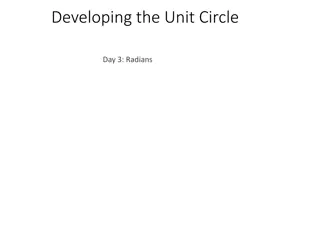
Maximizing Your Investments: Understanding Returns and Risks
Learn how to make your money work for you through smart investments. Explore the definition of investment, the difference between saving and investing, characteristics of investment returns, and the concept of risk in investments. Gain valuable insight into evaluating investments and strategies to optimize your financial resources for future gains.
Download Presentation

Please find below an Image/Link to download the presentation.
The content on the website is provided AS IS for your information and personal use only. It may not be sold, licensed, or shared on other websites without obtaining consent from the author. If you encounter any issues during the download, it is possible that the publisher has removed the file from their server.
You are allowed to download the files provided on this website for personal or commercial use, subject to the condition that they are used lawfully. All files are the property of their respective owners.
The content on the website is provided AS IS for your information and personal use only. It may not be sold, licensed, or shared on other websites without obtaining consent from the author.
E N D
Presentation Transcript
INVESTMENT How To Make Your Money Work For You Presented By: Dr. Muzaffar Ahmad Dar
Definition Investment is defined as the commitment of current financial resources in order to achieve higher gains in the future. It deals with what is called uncertainty domains. From this definition, the importance of time and future arises as they are two important elements in investment. Hence, the information that may help shape up a vision about the levels of certainty in the status of investment in the future is significant. From an economic perspective, investment and saving are different; saving is known as the total earnings that are not spent on consumption, whether invested to achieve higher returns or not. Consumption is defined as one s total expenditure on goods and services that are used to satisfy his needs during a particular period. The values of investment or saving, as well as consumption, can be determined at the macroeconomic level, or at the individual level, through different statistical methods.
Cont.. Generally, investment is the application of money for earning more money. Investment also means savings or savings made through delayed consumption. According to economics, investment is the utilization of resources in order to increase income or production output in the future. According to finance, the practice of investment refers to the buying of a financial product or any valued item with anticipation that positive returns will be received in the future. The most important feature of financial investments is that they carry high market liquidity. The method used for evaluating the value of a financial investment is known as valuation. According to business theories, investment is that activity in which a manufacturer buys a physical asset, for example, stock or production equipment, in expectation that this will help the business to prosper in the long run.
Characteristics of investment Return All investments are characterized by the expectation of a return. In fact, investments are made with the primary objective of deriving a return. The return may be received in the form of yield plus capital appreciation. The difference between the sale price and the purchase price is capital appreciation. The dividend or interest received from the investment is theyield. The return from an investment depends upon the nature of the investment, the maturity period and a host of other factors. Return = Capital Gain + Yield (interest, dividend etc.)
Cont Risk Risk refers to the loss of principal amount of an investment. It is one of the major characteristics of an investment. The risk depends on the following factors: The investment maturity period is longer; in this case, investor will take larger risk. Government or Semi Government bodies are issuing securities which have less risk. In the case of the debt instrument or fixed deposit, the risk of above investment is less due to their secured and fixed interest payable on them. For instance debentures. In the case of ownership instrument like equity or preference shares, the risk is more due to their unsecured nature and variability of their return and ownership character. The risk of degree of variability of returns is more in the case of ownership capital compare to debt capital. The tax provisions would influence the return of risk.
Cont Safety: Safety refers to the protection of investor principal amount and expected rate of return. Safety is also one of the essential and crucial elements of investment. Investor prefers safety about his capital. Capital is the certainty of return without loss of money or it will take time to retain it. If investor prefers less risk securities, he chooses Government bonds. In the case, investor prefers high rate of return investor will choose private Securities and Safety of these securities is low. Liquidity: Liquidity refers to an investment ready to convert into cash position. In other words, it is available immediately in cash form. Liquidity means that investment is easily realizable, saleable or marketable. When the liquidity is high, then the return may be low. For example, UTI units. An investor generally prefers liquidity for his investments, safety of funds through a minimum risk and maximization of return from an investment.
Investment Decision Investment Decision is a part of Financial Management which deals with the allocation of the company s valuable funds into investment projects or potential assets. It involves identifying such projects or assets to invest in and generate returns from them. Besides, these decisions significantly affect the profitability and stability of the firm. Some essential investment decisions that organizations make are: Setting up new business Expansion of existing one Modernization of existing one For firms, investment decision plays an integral part in achieving their long-term goals. Usually, the amount invested is huge, and so is the associated risk. Along with value creation, it generates revenue and eases the firm s survival.
Goal of Investment Decisions The ultimate goal behind investment decisions is to maximize returns and enhance the firm s profit-earning capacity. Also, it ensures optimum investment to deliver value for companies shareholders. Investment decisions directly affect the profitability of the firm. It affects the current and future cash flows as well as the profit earned by the firm. Any investment can be characterized by three factors: safety, income, and capital growth. Every investor has to pick an appropriate mix of these three factors. One will be preeminent. The appropriate mix for you will change over time as your life circumstances and needs change. Safety It is said that there is no such thing as a completely safe and secure investment. But you can get pretty close. Investing in government-issued securities in stable economic systems is one.
Types of investment decision Investment decisions are categorized under two heads based on the duration of the investment. This is because, returns generated differ in the short and long term. The two types of investments are explained as under: Long-term Investment Decisions These decisions are popularly known as Capital Budgeting Decisions or Capital Investment Decisions. This is because, it involves the investment in fixed or capital assets. These decisions are crucial because any wrong decision may endanger the firm s existence. The capital budgeting decisions include: Purchase of the fixed asset Replacement of an existing asset Expansion of business Setting-up new business Short-term Investment Decisions These investments are made on the current assets, which is why they are termed Working Capital Decisions. It plays a vital role in the smooth functioning of the firms. It involves investments in Inventory, Bills Receivables, Debtors and so on. These decisions affect the firms earning capacity, profitability, liquidity and solvency. Cash management and inventory control are important parts of such decisions.
Examples of Investment Objectives and Basic Types Your investment objective can be considered growth but it may also be income or preservation if you're retired, or it can be some combination or variation of those types. For example, some investors want to grow their account value over time but they also want to take some income from their investments. Therefore, this investment objective can be considered growth and income. Preservation objectives will usually seek to keep account values stable or, at a minimum, grow at a rate equal to the expected rate of inflation, which is usually around 3.5% to 4.0% for investing purposes.
Investment assets Real Assets: They are tangible assets used to produce goods or services, such as buildings, land, machinery, or cognitive assets that are utilized in the production of commodities or services. Financial Assets: Are claims on real assets or income produced by those assets. Examples include stocks and bonds which are alone no more than just worthless papers and do not directly contribute to the production of a commodity or service, but derive their value from the claims they carry. The evaluation of real assets differs in some way from financial assets due to their differences. Financial assets are more liquid, and have a more regulated market. They are also fragmented into small parts which makes it easier for a larger number of interested people to enter the market. For example, let us compare between buying a car or a plot of land, and buying a stock. You need a lot of money to buy a car or a plot compared to buying one share in a particular company. It is also easier to sell the stock faster than the car or plot. Therefore, financial assets are more popular for many. You can say that the two kinds of assets (real & financial) have different elements that affect their evaluation, and both have their own market. The market related to the financial assets is called the financial market.
Indian Securities Market The securities market provides an institutional framework for efficient flow of capital in the economy. Capital markets converts saving into investments for the investor and it converts business pedigree into funding for the businesses. This basic arrangement in the securities markets enables flow of capital from households to business, in a regulated institutionalized framework. The securities market include equities, index futures, index options, stock futures, stock options, long term bonds, medium term bonds, short term bonds, money market securities, equity funds, debt funds, hybrid funds, structured products, REITS, INVITs etc. The market in which securities are issued, purchased by investors, and subsequently transferred among investors is called the securities market. The securities market has two interdependent and inseparable segments, viz., the primary market and secondary market. The primary market, also called the new issue market, is where issuers raise capital by issuing securities to investors. The secondary market also called the stock exchange facilitates trade in already-issued securities, thereby enabling investors to exit from an investment. The risk in a security investment is transferred from one investor (seller) to another (buyer) in the secondary markets. The primary market creates financial assets, and the secondary market makes them marketable..
What role do participants play in the securities market? Here are the key intermediaries in the securities market and the role that they play Stock Exchanges provide the infrastructure for trading in securities that have been issued at prices that reflect its current value and also helps discover a fair value for the stock. It also provides liquidity to the investors when they require funds. Stock exchanges appoint clearing and settlement agencies and clearing banks to handle clearing and settlement of securities. Depository participants facilitate investors to hold and transact in securities in dematerialised form. They service customers on behalf of one of the depositories; NSDL or CDSL. Demat has gone a long way to make the Indian stock market system clean and transparent. Custodians work with institutional investors and hold securities and manage bank accounts on behalf of institutional investors. They manage the transactions pertaining to delivery of securities and money after a trade is made through the broker, and also keeps the accounts of securities and money. Stock brokers are registered trading members of stock exchanges. They sell new issuance of securities to investors. They put through the buy and sell transactions of investors on stock exchanges. Investment Bank s activities include advisory for business expansions, project financing, mergers and acquisition, investment valuation, among others, new issue management etc. Commercial Banks provide banking services of taking deposits, providing credit and enabling payment services. They provide efficient cash management for businesses.
Cont Insurance Companies provide service of insuring life, property and income against unexpected and large charge. Life insurance companies deal with insuring the life of individuals while general insurance covers health, motor, travel and other areas, where a sudden large expense can derail the financial situation of a household or business. Insurance companies use channels such as individual and corporate agents, brokers and banks to sell their products. Given the large resources mobilized by insurance companies by way of premiums, they are an important source of long-term funding for government and businesses. Pension Funds take contributions from eligible individuals and invest these funds according to the directions of the contributors to create a retirement corpus. These funds provide different options for investment of the contribution, such as debt, equity or a combination. Investors select the type of fund and these are long term retirement funds. AMCs and Portfolio Managers are investment specialists who manage a portfolio of securities and other assets. Against this portfolio, these asset managers either issue units or PMS accounts to create wealth over the long run. Investment Advisers and distributors help investors to make a choice of securities that they can buy based on an assessment of their needs, time horizon return expectation and ability to bear risk. The idea is to work towards a long term financial plan.
Types of Primary Issues and Types of Issuers Here are some of the popular primary issue types that are available. Public issue securities are issued to the public Private placement securities issued to select investors Preferential issue securities issued to identified investors Qualified Institutional Placement issued to institutional investors only Rights and Bonus issues issued to existing shareholders on record date Here are some of the types of issuers of securities Central and State governments raise funds through G-Sec, treasury bills, dated securities, State Development Loans (SDLs) etc. Public Sector Units (PSUs) raise monies through issue of shares, bonds, tax-exempt bonds, tax-free bonds etc. Private Sector Companies raise funds in the market through equity or debt securities, preference shares, and CPs and convertible instruments. Banks, DFIs and NBFCs raise funds via equity shares, preference shares, bonds, convertible bonds, commercial paper, certificates of deposits and securitized paper. Mutual Funds make NFOs of units in the domestic markets and also through closed ended funds and interval funds. REITs and INVITs also issue pass through securities against a portfolio of realty properties or infrastructure project pools.
Structure of Financial Markets in India This is popularly referred to as financial intermediation and exists at the core of the Indian economy; bringing investors and businesses together in a symbiotic relationship. Here is what it consists of. The Banking System Indian banking has a multi-tier structure. The Reserve Bank of India is the regulator of the banking system and the monetary authority. Its functions include licensing banks and regulation for a strong and stable banking system. RBI is the note-issuing authority and banker to the government and acts as a lender of last resort to the other banks. It also acts as a controller of credit in the monetary system. On the banking front there are PSU banks, private banks; cooperative banks, small finance banks etc. and they combine to define the Indian banking system. Indian Securities Market The securities market provides an institutional framework for efficient flow of capital in the economy. Capital markets converts saving into investments for the investor and it converts business pedigree into funding for the businesses. This basic arrangement in the securities markets enables flow of capital from households to business, in a regulated institutionalised framework. The securities market include equities, index futures, index options, stock futures, stock options, long term bonds, medium term bonds, short term bonds, money market securities, equity funds, debt funds, hybrid funds, structured products, REITS, INVITs etc. Security markets are an important for raising money for corporates and institutions and also for investors to allocate their money. Indian Commodities Market Commodity market facilitates transactions between buyers and sellers of commodities. These commodities are broadly dividend into four categories viz. agricultural commodities, precious metals, industrial metals and energy products (oil and gas). Commodities can be traded in India in the spot market (for immediate delivery) or in the futures market (for delivery), or in the futures market (not for delivery) or in the options (so as to devolve into commodity futures). Commodity markets are essentially used by industries, traders, importer and exporters to hedge the commodity price risk
Cont Foreign Exchange Market or Forex Market This is where the currencies are exchanged and there are traders, arbitrageurs, speculators and hedgers in these markets. Globally, the forex trading market is the largest compared to other asset classes. The growth of international trade made it necessary to be able to determine the relative value of currencies given the differences in their purchasing power. The need for exchanging one currency to another for settling trades in goods and services brought about foreign exchange risk and that created a robust forex market. India has had the rupee forward market offered by banks for a long time, but that is offered by banks only against actual exposure. Today, it is possible to also trade currency pairs in the currency derivatives segment of the stock exchange. The USDINR pair is, obviously, the most popular and extensively traded currency pair Indian Insurance Market Insurance business in India is regulated by the Insurance Regulatory and Development Authority (IRDA) of India. It regulates life and non-life insurance activities in India. Insurance is all about sharing of risk. Broadly, there are 3 sub categories in insurance viz. life insurance, non-life insurance and re-insurance. Insurance in India is still fairly underpenetrated. For long the insurance business was dominated by the government owned companies but that has changed over the last 20 years with the entry of private players. Indian Pension Market Much of the Indian population is still outside the formal retirement benefit cover provided by the government and its associated organisations, and companies covered under the Employees Provident Fund Organisation (EPFO). In provident fund contribution, a portion of the employers contribution is earmarked to provide pension under the Employee Pension scheme. Some private companies may provide Superannuation plans and privately sponsored pension plans to their employees. The National Pension System (NPS) is a defined contribution pension scheme now applicable to government employees, where the employee and the government make matching contributions to a fund of the employee s choice, managed by licensed fund managers.
What are stock market indices? A stock market index abbreviated as a stock index is an indicator that shows all the major changes in India's stock market. The same stocks are selected from amongst the securities already grouped and listed on the stock exchange to develop an index. However, the selection criteria are based upon the type of industry, the company's size, and its market capitalization. This indicator is used to minimize the mess up and indicate the proper position of the market. Changes in the price of underlying assets impact the overall value of the index. If the price goes upwards, the stock index will rise, and if they go downwards, the stock will fall. There are three different types of stock market indices mentioned below: 1) Benchmark Indices 2) Sectoral Indices 3) Market-Cap Based Indices
Cont Benchmark Indices Nifty 50 a collection of top 50 best-performing stocks and BSE Sensex a collection of top 30 best-performing stocks are indictors of the National Stock Exchange and Bombay Stock Exchange, respectively. This collection of stocks are known as benchmark indices respectively because they use the best practices to regulate the companies they pick. Hence they are known as the best point of reference for the working of markets in general. Sectoral Indices Both BSE and NSE have some good indicators that measure companies falling under one specific sector. Indices like S&P BSE Healthcare and NSE Pharma are considered good indicators of their respective changes in the pharmaceutical sector. Another prominent example could be S&P BSE PSU, and Nifty PSU Bank Indices are indicators of all the listed public sector banks. However, both the exchanges don't have corresponding indices for all the sectors, but this is generally a significant cause. Market-Cap Based Indices Few indices choose companies based on their market capitalization. Market capitalization means the market value of any public traded company in the stock exchange. Indices like S&P BSE and NSE small cap 50 are a collection of companies that have a lower market capitalization in accordance with the rules set by the Security Exchange Board of India (SEBI). Other Indices Several other indices like S&P BSE 500, NSE 100, S&P BSE 100, among others, are slightly larger indices and come with a more significant number of stocks listed on them. You may have a low-risk appetite and stock listed on Sensex may have a high-risk appetite. Investment portfolio are not tailored to meet every needs. So investor has to be focused and invest in which they feels safe.
Concept of Return Return refers to the gain or loss generated on an investment over a specific period, expressed as a percentage of the initial investment amount. It represents the reward investors expect for taking on risk. Returns can come from various sources, such as capital appreciation (increase in the value of an asset), dividends, interest payments, or rental income. Types of Returns: Capital Gains: Profits earned from selling an asset at a higher price than its purchase price. Dividend Income: Payments made by a corporation to its shareholders out of its profits. Interest Income: Income earned from interest payments on bonds, loans, or savings accounts. Rental Income: Income generated from renting out properties.
Concept of Risk Risk refers to the uncertainty or variability associated with the potential returns of an investment. It encompasses the possibility of losing some or all of the invested capital, as well as the variability of returns over time. Different investments carry different levels of risk, and generally, higher potential returns are associated with higher levels of risk. Types of Risk: Market Risk: The risk that an investment's value will decrease due to factors affecting the overall market, such as economic conditions, geopolitical events, or changes in investor sentiment. Credit Risk: The risk that a borrower or issuer will default on their debt obligations, leading to losses for the investor. Interest Rate Risk: The risk that changes in interest rates will affect the value of fixed-income securities, such as bonds. Liquidity Risk: The risk that an investor may not be able to buy or sell an investment quickly at a fair price. Inflation Risk: The risk that the purchasing power of investment returns will be eroded over time due to inflation.






















